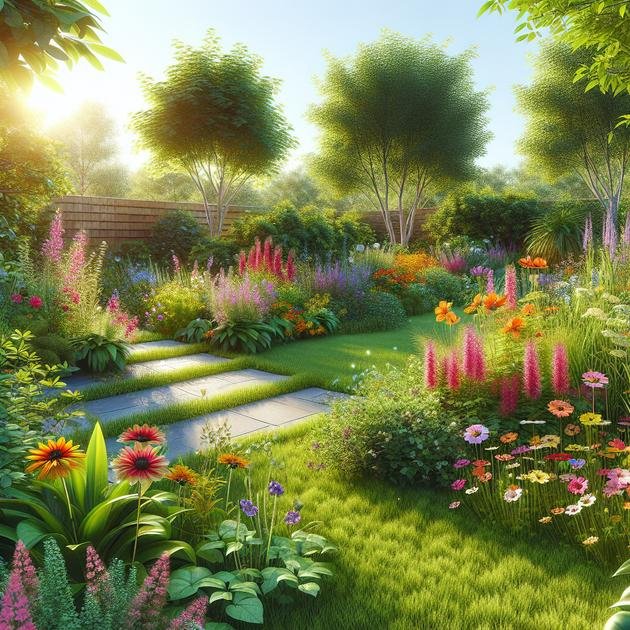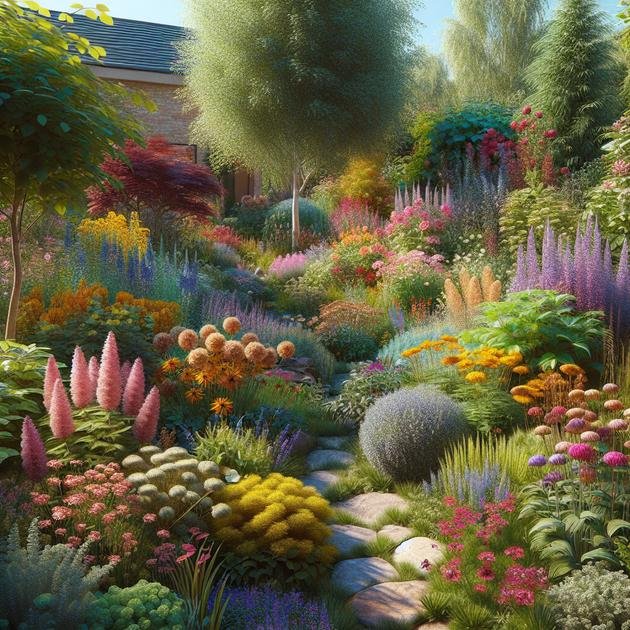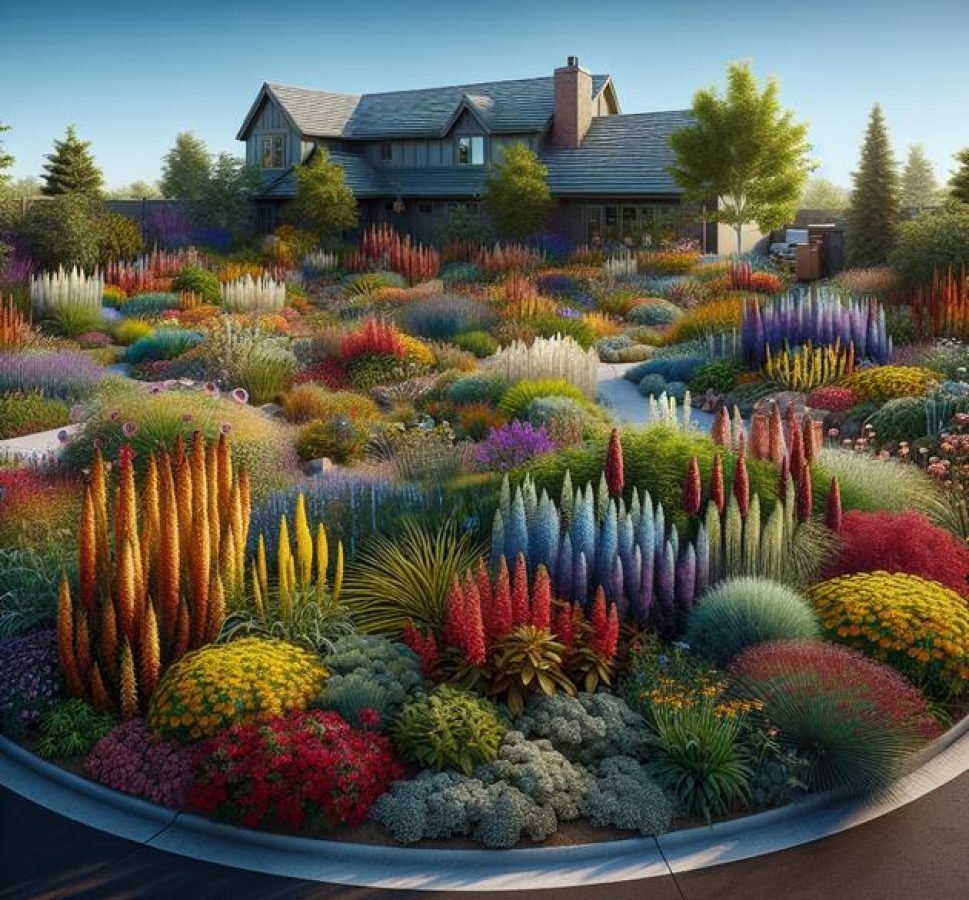Native plants landscaping uses local species adapted to your climate, reducing water and maintenance needs while supporting wildlife and enhancing garden health.
Native plants landscaping might seem tricky at first, but it’s a rewarding way to create a thriving garden that fits its environment naturally. Ever wondered how these plants can totally change your outdoor space without demanding too much effort? Let’s explore this together.
why choose native plants for landscaping
Choosing native plants for landscaping offers many advantages that benefit both your garden and the environment. Native plants are naturally adapted to the local climate, soil, and wildlife, making them easier to grow and maintain with less water and fertilizer. This means your garden will be more sustainable and require less effort year-round.
Because they have evolved in the same region, native plants provide essential food and shelter for local wildlife such as birds, bees, and butterflies. This helps support biodiversity and promotes a balanced ecosystem. Additionally, native plants often have deep root systems that improve soil health and reduce erosion.
Incorporating native species can also reduce the spread of invasive plants that may harm the local environment. With a wide range of native plants available, you can create beautiful, unique landscapes that reflect the natural beauty of your area while conserving resources.
benefits of using native plants
Using native plants in your landscaping offers multiple key benefits that make your garden healthier and more resilient. Native plants are well-adapted to the local climate, meaning they need less water and fertilizers, which saves resources and reduces maintenance efforts.
They support biodiversity by providing food and habitats for native birds, insects, and pollinators like bees and butterflies. This helps create a balanced ecosystem and encourages natural pest control.
Another advantage is that native plants generally have deep root systems that improve soil structure and reduce erosion. They also increase the landscape’s resistance to drought and extreme weather. Adopting native plants helps protect local plant species and prevents the spread of invasive species that can disrupt native habitats.
Overall, landscaping with native plants promotes sustainability and a thriving environment that benefits both homeowners and nature.
how to identify native plants in your area
Identifying native plants in your area begins with researching the local ecosystem and climate. Start by consulting regional plant guides or websites dedicated to native flora. These resources often include photos, descriptions, and blooming seasons that help you recognize plants suited to your region.
Visiting local botanical gardens and nature reserves can provide hands-on experience. Observe the plants thriving naturally in these environments, noting their leaf shapes, flower colors, and growth habits.
Mobile apps equipped with plant identification features can help you identify plants by simply taking photos. These tools analyze leaf patterns, flowers, and other features to suggest possible matches. Joining local gardening groups or native plant societies may also offer valuable insights.
Keep in mind that true native plants have evolved over thousands of years in your specific area. Signs of native status include adaptability to local conditions, attraction of native wildlife, and resistance to local pests.
preparing your soil for native plants

Preparing your soil properly is essential for the success of native plants. Start by testing your soil to determine its pH, texture, and nutrient levels. This information will guide you in making any necessary amendments to create the best conditions for native species.
Most native plants prefer soil that is well-drained and rich in organic matter. You can improve your soil by adding compost or aged mulch, which increases nutrients and supports healthy root development. Avoid heavy tilling, as it can disrupt the natural soil structure and beneficial organisms.
Removing weeds and invasive plants before planting is important to reduce competition. Consider layering mulch to help retain moisture and control weeds after planting. It’s also helpful to choose plant locations that mimic their natural habitats, whether that means sunny, shady, or moist spots.
With proper soil preparation, native plants establish stronger roots and are better equipped to thrive with less maintenance.
designing a landscape plan with native plants
Designing a landscape plan with native plants starts with assessing your site’s conditions such as sunlight, soil type, and drainage. Mapping these details helps you choose native plants that will thrive naturally in each area.
Consider the overall structure of your landscape. Use a mix of trees, shrubs, and groundcovers to create layers and visual interest. Group plants with similar water and light needs together to simplify maintenance.
Incorporate paths, seating areas, and focal points into your design to enhance usability and aesthetics. Use curves and natural shapes to mimic the flow of native landscapes.
Think about seasonal changes by selecting plants with varying bloom times, colors, and textures. This ensures your garden remains attractive year-round and supports wildlife throughout the seasons.
Planning for growth is essential — allow enough space for plants to mature without overcrowding. Native plants often spread naturally, so design with room for this expansion.
selecting the right native plants for your climate
Selecting the right native plants for your climate is key to creating a successful and sustainable landscape. Begin by understanding your local climate zone, including temperature ranges, rainfall, and seasonal changes. This knowledge helps you pick plants naturally suited to thrive in your area.
Research native species that are adapted to specific conditions such as drought tolerance or resistance to frost. Using local plant nurseries or native plant societies as resources can guide you in making informed choices.
Consider factors like sunlight exposure and soil type when selecting plants to ensure they can grow strong and healthy without extra care. Group plants with similar needs to simplify watering and maintenance.
Choosing appropriate native plants reduces the need for fertilizers and pesticides, promotes local wildlife, and supports the health of your ecosystem.
Remember, selecting plants adapted to your climate saves time and resources while enhancing your garden’s beauty and resilience.
planting techniques for native species
Planting native species requires specific techniques to ensure strong establishment and growth. Start by choosing healthy plants or seeds suited to your local environment. Dig holes that are twice as wide but only as deep as the root ball to allow roots to spread easily.
Loosen the soil around the hole to help roots penetrate. Place the plant carefully, making sure that the top of the root ball is level with the soil surface. Backfill with native soil mixed with compost to improve nutrient content.
Water thoroughly after planting to settle the soil around the roots and reduce air pockets. Apply a layer of mulch to help retain moisture, regulate soil temperature, and suppress weeds.
Spacing between plants should allow room for mature size and airflow to prevent disease. Avoid overcrowding to promote healthy growth.
During the first months, monitor moisture levels closely—native plants may need regular watering until they are well established, especially during dry spells.
watering and maintenance tips

Watering native plants correctly is vital for their growth and health. Most native plants require less water than non-native species because they are adapted to local rainfall patterns. Water deeply but infrequently to encourage strong root growth. Avoid shallow, frequent watering that can weaken roots.
It’s best to water early in the morning or late in the evening to reduce evaporation and help plants absorb moisture efficiently. Use drip irrigation or soaker hoses to deliver water directly to the soil, minimizing waste.
Maintenance for native plants is generally lower but still important. Regularly remove weeds that compete for nutrients and water. Mulching helps retain moisture and suppress weeds, so replenish mulch as needed.
Prune plants to remove dead or damaged branches and to shape growth. Monitor plants for pests or diseases and address issues naturally when possible to maintain a healthy ecosystem.
Seasonal care, like protecting plants during extreme weather, ensures your native landscape continues to thrive year after year.
how native plants support local wildlife
Native plants play a crucial role in supporting local wildlife by providing food, shelter, and breeding grounds. Many native animals, such as birds, butterflies, and bees, rely on native plants for nectar, seeds, and habitat.
Unlike non-native species, native plants have evolved alongside local wildlife, creating a balanced ecosystem. For example, native wildflowers attract pollinators, which are essential for plant reproduction and food production.
Native trees and shrubs offer nesting sites for birds and small mammals, while dense groundcovers provide shelter for insects and amphibians. This interconnected relationship helps maintain biodiversity and strengthens the resilience of the environment.
By incorporating native plants into your landscape, you contribute to the conservation of wildlife and promote a healthy ecosystem that benefits both nature and communities.
managing pests naturally with native plants
Managing pests naturally with native plants is an effective way to maintain a healthy landscape without relying on chemical pesticides. Native plants attract beneficial insects like ladybugs, lacewings, and predatory wasps that help control harmful pests by feeding on them.
These plants are often more resistant to local pests because they have co-evolved with them. This makes them less likely to suffer severe damage and reduces the need for intervention.
Planting a variety of native species increases biodiversity, which creates a balanced habitat where pests are kept in check by natural predators. Companion planting, where certain native plants are strategically placed next to others, can also deter specific pests.
Regular monitoring of your garden and removing affected plant parts can prevent pest outbreaks. Mulching and maintaining healthy soil also support plant resilience against pests.
Using native plants for pest management supports a sustainable landscape and promotes a thriving ecosystem without harmful chemicals.
common mistakes to avoid when landscaping native plants
When landscaping with native plants, avoiding common mistakes can ensure a thriving garden. One frequent error is choosing plants that do not suit the specific soil, light, or moisture conditions of your site. This mismatch can lead to poor growth or plant death.
Another mistake is overcrowding plants, which reduces airflow and increases disease risk. It’s important to space plants according to their mature size.
Neglecting proper soil preparation, such as failing to test and improve soil quality, can also weaken native plants. Additionally, overwatering is a common problem since many native species require less water than non-natives.
Using invasive or non-native plants among native landscaping can harm the ecosystem by competing with local species. It’s vital to avoid introducing such plants.
Finally, neglecting maintenance like mulching, weeding, and monitoring plant health can cause preventable issues. Staying attentive to your native landscape helps it stay healthy and sustainable.
incorporating native plants in small spaces

Incorporating native plants in small spaces is a great way to create a vibrant, low-maintenance garden. Start by selecting compact or dwarf native species that fit well within limited areas without overcrowding.
Use vertical gardening techniques like trellises or wall planters to maximize space and add visual interest. Group plants with similar needs together to simplify care.
Container gardening with native plants is also effective for patios, balconies, or small yards. Choose pots with good drainage and use native soil mixes to support healthy growth.
Integrate native groundcovers to fill in gaps and reduce weeds, while adding texture and color to your garden. Including flowering native plants can attract pollinators even in small urban settings.
Smart planning and plant selection allow you to enjoy the benefits of native landscaping, even when space is limited.
seasonal care for native plant gardens
Seasonal care is essential to keep native plant gardens healthy and thriving throughout the year. In spring, focus on removing debris and dead plant material to encourage new growth. Pruning damaged branches helps plants recover and shape nicely.
During summer, monitor watering closely since native plants may need supplemental irrigation in dry periods. Mulching helps retain moisture and keeps roots cool.
Fall is a good time for planting new native species and dividing overgrown perennials. It’s also important to collect seeds from mature plants to support propagation.
In winter, protect sensitive plants from frost by applying mulch or using covers as needed. Avoid heavy pruning during dormancy to prevent stress.
Regular seasonal care practices ensure your native plant garden remains resilient, supporting local wildlife and enhancing your landscape’s beauty year-round.
resources for native plant identification and sourcing
Finding reliable resources for native plant identification and sourcing is essential for successful landscaping. Start with online databases and websites like the Lady Bird Johnson Wildflower Center or state native plant societies, which offer detailed information and photos to help identify native species.
Mobile apps such as iNaturalist and PlantSnap provide easy and accurate plant identification by allowing you to upload photos of plants for instant identification.
Local botanical gardens and native plant nurseries are valuable physical resources for seeing native plants in person and purchasing healthy specimens. Joining native plant gardening groups or forums online can also offer advice and plant exchange opportunities.
For sourcing plants, reputable native plant nurseries specialize in propagation of local species suited to your region. Ensure plants are grown from local seed stock to maintain genetic diversity and ecological balance.
Utilizing these resources allows you to confidently select, identify, and source native plants, promoting a thriving and sustainable garden.
case studies of successful native plant landscapes
Several case studies highlight the success of landscaping with native plants in various environments. A suburban community in California transformed its public spaces using drought-tolerant native species, which significantly reduced water use and maintenance costs while attracting local wildlife like hummingbirds and butterflies.
In the Midwest, a city park underwent restoration by replacing invasive plants with native prairie grasses and wildflowers. This initiative improved soil health, increased biodiversity, and created educational opportunities for visitors about the native ecosystem.
Another example comes from a coastal area where homeowners replaced non-native lawns with salt-tolerant native plants, resulting in stronger resilience to storms and reduced erosion.
These case studies demonstrate that native plant landscapes can be beautiful, sustainable, and functional solutions tailored to diverse needs and climates.
Learning from these real-life projects can inspire and guide your own native plant landscaping efforts for long-term success.
Embrace native plants for a beautiful, sustainable landscape
Landscaping with native plants offers numerous benefits from saving water to supporting local wildlife. These plants are easier to care for and thrive naturally in your climate.
By choosing the right species and following practical planting and maintenance tips, you can create a garden that is both vibrant and eco-friendly. Real-life examples show how native plant landscapes enhance communities and reduce environmental impact.
Start small, explore resources, and enjoy the beauty and resilience native plants bring to your outdoor space.
Native plants landscaping is not just a trend — it’s a smart choice for a healthy planet and a thriving garden.





